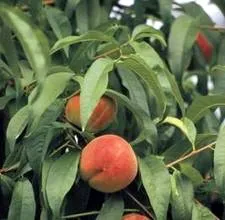 Prunus persica L. represents the eight most important fruit crop worldwide. Most peaches and nectarines are consumed naturally. The peach cultivation expansion depends on the introduction of new technologies in the plantlets production. Peach trees can be propagated by seed germination, cutting, and grafting.
Prunus persica L. represents the eight most important fruit crop worldwide. Most peaches and nectarines are consumed naturally. The peach cultivation expansion depends on the introduction of new technologies in the plantlets production. Peach trees can be propagated by seed germination, cutting, and grafting.Growers commonly employ grafting techniques using almond rootstocks and obtain grafted plantlets within 12 to 24 months. A significant time reduction to obtain grafted plantlets with a proper size for market could be achieved using hydroponic techniques, which have been applied successfully for the propagation of woody and ornamental plants, leafy vegetables, and fruits such as strawberry and passion fruit.
Although the initial costs are high, hydroponic systems offer many advantages, such as allowing out of season production, reducing infection by pests and diseases, increase the crop yield, and improve the product quality. In addition, plants grown by hydroponic systems can be standardized due to the system being automated and mechanized, also water consumtion and fertilizers used are significantly reduced. Hydroponic systems represent a possible alternative to the current conventional methods to produce certified peach grafts.
The objectives of the work conducted by Souza et al. (2011) were:
- to evaluate the viability of production of ‘Okinawa’ rootstocks and peach under hydroponic conditions;
- to evaluate the effects of pruning different portions of the rootstocks on the following development of scion shoots.
The second phase of the study consisted of grafting scions from two peach cultivars ‘Diamante’ and ‘Aurora’ onto hydroponically-grown ‘Okinawa’ rootstocks. Inverted T budding was performed at a distance of 15 cm from the crown of the rootstocks. Twenty days after budding, the rootstocks were pruned above the scion bud at approximately (5 cm), median and distal position from the scion. The grafts were grown under hydroponic conditions until they reached a proper size (40 cm height) for commercialization. During this phase, the percentage of sprouting grafts at 20 days after grafting and the height of the shoots were measured.
‘Okinawa’ rootstocks reached transplanting stage within 30 days after being transferred to hydroponic conditions whereas 75% of the plantlets reached the grafting stage from 60 to 80 days. The researchers, by comparing the results of this work to other studies have obtained the best results reducing further the time for the rootstock required to reach the grafting stage.
In the second phase, both peach cultivars grafted on ‘Okinawa’ reached 100% of sprouting. After 133 days of hydroponic conditions, the plantlets reached a mean height of 25 cm, after only 126 days, the cultivar choice influenced significantly the plantlet growth. ‘Aurora’ plantlets were higher than ‘Diamante’ plantlets. Proximal pruning (at 5 cm from the scion bud) improved the growth of the grafts that presented the characteristics required for the commercialization at 116 days after transference to hydroponic conditions.
The study has demonstrated that hydroponic system can produce fruit grafts and to reduce the time for the plantlets to reach transplanting stage.
Original study: Souza A.D.G., Chalfun N.N.J., Faquin V., Souza A.A., "Production of peach grafts under hydroponic conditions", 2011, Ciencia e Agrotecnologia, Issue No. 35(2), pagg. 322-326. For more details: www.scielo.br/scielo.php?pid=S1413-70542011000200013&script=sci_abstract
